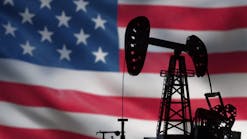Section 211(i) of the U.S. 1990 Clean Air Act Amendments requires the petroleum industry, beginning Oct. 1, 1993, to differentiate off-highway diesel clearly from highway diesel using a "dye marker" system.
Starting Oct. 1, all highway diesel must comply with a maximum sulfur specification of 0.05 wt % and a minimum cetane index of 40 (or a maximum aromatics content of 35%). The U.S. Environmental Protection Agency (EPA) has been authorized to use 1,4-dialkylaminoanthroquinone, a blue dye, to mark higher sulfur off-highway diesel.
When added to diesel fuel, which is characteristically yellow, the fuel turns blue-green. If EPA officials find the colored fuel in highway use, the responsible parties will be fined. The EPA will use random testing and sampling to catch offenders.
ENFORCEMENT
The new law will affect refiners, importers, distributors, resellers, carriers, retailers, and wholesale purchaser-consumers who manufacture, introduce into commerce, sell, offer for sale, supply, dispense, offer for supply, or transport any diesel fuel used in motor vehicles.
The EPA's investigators and enforcement division will conduct field inspections of all affected parties, from fuel manufacturers to fleet operators. The inspections will be conducted on a "surprise" basis.
The maximum civil penalty for violations is a $25,000 fine per violation per day. Prior to assessing a fine, however, EPA will take into account the size of the business involved and its compliance history regarding other EPA regulations.
COMPLIANCE
Ideally, the dye should be injected into the fuel at the refinery. Each person or company affected by the regulation, however, will be responsible for adding the dye to the fuel if it has not been added already.
Affected parties must therefore be prepared to purchase both the dye concentrate and the injector hardware. Fuel-sampling equipment also will be necessary for compliance-assurance purposes.
MATERIALS
The specialty chemicals group of Morton International Inc., Chicago, produces the EPA-approved dye under the name Automate Blue 8.
Morton is the only company to produce the dye concentrate. Automate Blue 8 concentrate is sold as a xylene solution.
Hammonds Technical Services Inc., Houston, manufactures the only additive-injection systems that offer dye-concentrate injection and an economical 100% redundancy feature with fail-safe backup, says the company.
Hammonds injectors utilize a fluid-powered motor, borrowing just enough energy from the flowing product line to operate positive-displacement additive pumps. These pumps inject the dye upstream of the fluid motor, which aids the blending process. As a result, there is no need for explosion-proof electricity, air pressure, pulsars, or pressurized additive lines.
The proportion-to-flow injectors are a single piece of equipment with interchangeable additive pump heads. These heads provide the redundancy backup and failsafe features necessary to ensure that the dye is being added.
The injector-called 800 CAS-dispenses precise quantities at an almost continuous rate, eliminating the "sludging" effect found in most meter-pulsed injectors, according to Walter Chartrand, Hammonds' director of marketing.
The cost of an additive-injector system can range from $10,000 to $20,000, depending on the equipment selected. The dye will cost about 5cts/100 gal, depending on the fuel's background color.
Copyright 1993 Oil & Gas Journal. All Rights Reserved.


